| کد مقاله | کد نشریه | سال انتشار | مقاله انگلیسی | نسخه تمام متن |
|---|---|---|---|---|
| 592835 | 1453916 | 2014 | 12 صفحه PDF | دانلود رایگان |
• Proteins contained in a broth medium increase the solubility of ZnO particles.
• The respective activities of ZnO and Zn2+ show specificity with respect to the microorganisms.
• The contribution of Zn2+ to the antimicrobial activity of ZnO depends on the strain.
• The dissolution process depends on time, ZnO concentration, and type of ZnO powder.
• The combination of the three antimicrobial mechanisms of ZnO is beneficial.
Zinc ions (Zn2+) exhibit antimicrobial activity against various bacterial and fungal strains. The partial dissolution of zinc oxide (ZnO) particles releases Zn2+ ions in aqueous suspension that contributes to the antimicrobial activity of ZnO. In addition to the activity of the soluble zinc species that is common with water-soluble zinc salts, ZnO combines two additional mechanisms of antimicrobial activity that supplement its activity as preservative in topical formulations: generation of reactive oxygen species and by direct contact to the cells walls. The present study aims at the evaluation of the contribution of the soluble zinc species to the antimicrobial activity of ZnO on microbial cultures in broth medium and the investigation of the dissolution of zinc from ZnO suspensions. The antimicrobial activities against the five microorganisms of the Challenge Tests were measured for suspensions of three ZnO grades in broth, and for the isolated liquid phase of the suspensions containing soluble zinc species. The Zn2+ released in the broth brought about a significant contribution to the overall antimicrobial activity of ZnO. The complexation of Zn2+ ions by the components of the broth increased the solubility of the zinc in the liquid medium. The respective activities of the soluble zinc species and ZnO particles showed specificity with respect to the microbial strains. Dissolution was faster for high concentrations of ZnO and for ZnO powders of larger specific area. Such conditions led to a better antimicrobial efficacy of ZnO powders. ZnO appears an advantageous alternative to soluble zinc salts such as zinc gluconate.
Figure optionsDownload as PowerPoint slide
Journal: Colloids and Surfaces A: Physicochemical and Engineering Aspects - Volume 457, 5 September 2014, Pages 263–274
